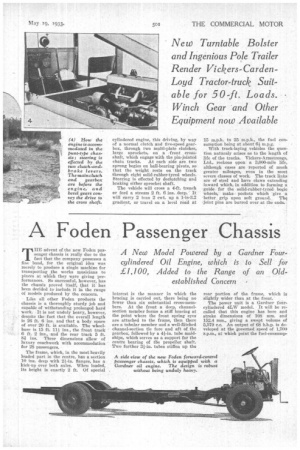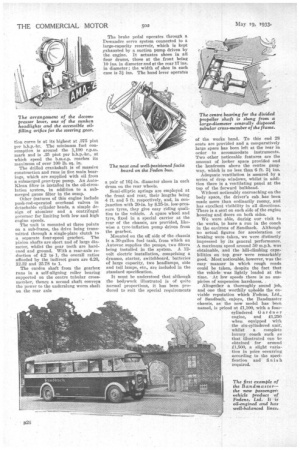Foden Passenger Chassis
Page 39

Page 40

If you've noticed an error in this article please click here to report it so we can fix it.
A New Model Powered by a Gardner Fourcylindered Oil Engine, which is to Sell for .£1,100, Added to the Range of an Oldestablished Concern
THE advent of the new. Foden passenger chassis is really due to the fact that the company possesses a fine band, for the original idea was merely to produce a single machine for transporting the works musicians to places at which they were giving performances. So successful, however, bas the chassis proved itself, that it has been decided to include it In the range of models produced by the concern.
Like all other Foden products the chassis is a thoroughly sturdy job and capable of withstanding prolonged hard • work. It is not unduly heavy, however, despite the fact that the overall length is 26 ft. 6 ins, and that a body space of over 20 ft. is available. The wheelbase is 15 ft. 11-4 ins., the front track • 6 ft. 2 ins., and the rear track 5 ft. bi ins. These dimensions allow of luxury coachwork with accommodation • for 28 passengers.
The frame, which, in the most heavily loaded part in the centre, has a section 30 ins, deep with 2i-in. flanges, has a kick-up over bath axles. When loaded, its height is exactly 2 ft. Of special
interest is the manner in which the bracing is carried out, there being no fewer than six substantial cross-members. At the front a deep, channelsection member forms a stiff bracing at the point where the front spring eyes are attached to the frame, then there are a tubular member and a well-flitched channel-section tie fore and aft of the gearbox, followed by a 41-in. tube amidships, which serves as a support for the centre bearing of the propeller, shaft. Two further 3-in. tubes stiffen up the
rear portion of the frame, which is slightly wider than at the front. '
The power unit is a Gardner fourcylindered 4LW model. It will be recalled that this engine has bore and stroke dimensions of 108 mm. and 152.4 mm., giving a swept volume of 5,579 c.c. An output of 68 b.h.p. is developed at the governed speed of 1,700 r.p.m., at which point the fuel-consump
tion curve is at its highest at .375 pint per b.h.p.-hr. The minimum fuel consumption is around the 1,100 r.p.m. mark and is .35 pint per b.h.p.-hr., at which speed the b.m.e.p. reaches its maximum of over 100 lb. sq. in.
The drilled crankshaft is of massive construction and runs in five main bearings, which are snpplied with oil from a submerged gear-type pump. An AutoKlean filter is installed in the oil-circulation system, in addition to a submerged gauze filter in the sump.
Other features of this engine include push-rod-operated overhead valves in detachable cylinder heads, a simple design of atomizer and a centrifugal governor for limiting both low and high engine speeds.
The -unit is mounted at three points on a sub-frame, the drive being transmitted through a single-plate clutch to a separate four-speed gearbox: The Pinion shafts are short and of large diameter, whilst the gear teeth are hardened and ground. With a rear-axle reduction of 4.2 to 1, the overall ratios afforded by the indirect gears are 6.26, 12.32 and 25.78 to 1.
The carden shaft from the gearbox runs in a self-aligning roller bearing supported on the centre tubular crossmember, thence a second shaft conveys the power to the miderslung worm shaft on the rear axle The brake pedal operates through a Dewandre servo system connected to a large-capacity reservoir, which is kept „exhausted by a suction pump driven by the engine. It actuates shoes in all four drums, those at the front being 10 ins, in diameter and at the rear 17 ins. in diameter ; the width of shoe in each case is 31 ins. The hand lever operates a pair of 16i-in. diameter shoes in each dram on the rear wheels.
Semi-elliptic springs are employed at the front and rear, their lengths being 4 ft. and 5 ft. respectively, and, in conjunction with 20-in. by 8.25-in. low-pressure tyres, they give easy riding qualities to the vehicle. A spare wheel and tyre, fixed in a special carrier at the rear of the chassis, are provided, likewise a tyre-inflation pump driven from the gearbox.
Mounted on the off side of the chassis is a 30-gallon fuel tank, from which an Autovac supplies the pumps, two filters being installed in the system. A 12volt electric installation, comprising a dynamo, starter, switchboard, batteries of large capacity, two headlamps, side and tail lamps, etc., are included in the standard specification.
It 'mist be understood that although the bodywork illustrated is of quite normal proportions, it has been produced to suit the special requirements
of the works band. To this end 28 seats are provided and a comparatively large space has been left at the rear in order to accommodate instruments. Two other noticeable features are the amount of locker space provided and the headroom above the centre gangway, which is no less than 6 ft. 21 ins.
Adequate ventilation is assured by a series of drop windows, whilst in addition there is a ventilating panel at the top of the forward bulkhead.
Without noticeably encroaching on the body space, the driver's cab has been made more than ordinarily roomy, and has excellent visibility in all directions. There is a seat on each side of the engine housing and doors on both sides.
We were able, daring our visit to the works, to have a run in the coach in the environs of Sandhaeh. Although no actual figures for acceleration or braking were taken, we were distinctly impressed by its general performance. A maximum speed around 50 m.p.h. was obtainable, and the hill-climbing capabilities on top, gear were remarkably good. Most noticeable, however, was the easy manner in which rough roads could be taken, despite the fact that the vehicle was lightly loaded at the time. At low speeds there is no suspicion of suspension harshness. .
Altogether a thoroughly sound job, and one that worthily upholds the enviable reputation which Fodens, Ltd., of Sandbach, enjoys, the Bandmaster chassis, as the new model has been named, is priced at £1,100, with a fourcylindered Gardner engine, and £1,250 when. equipped with the six-eylindered unit; whilst a complete luxury coach such as that illustrated can he obtained for around £1,500, a slight variation in price occurring according to the specification and finish required.




























































































